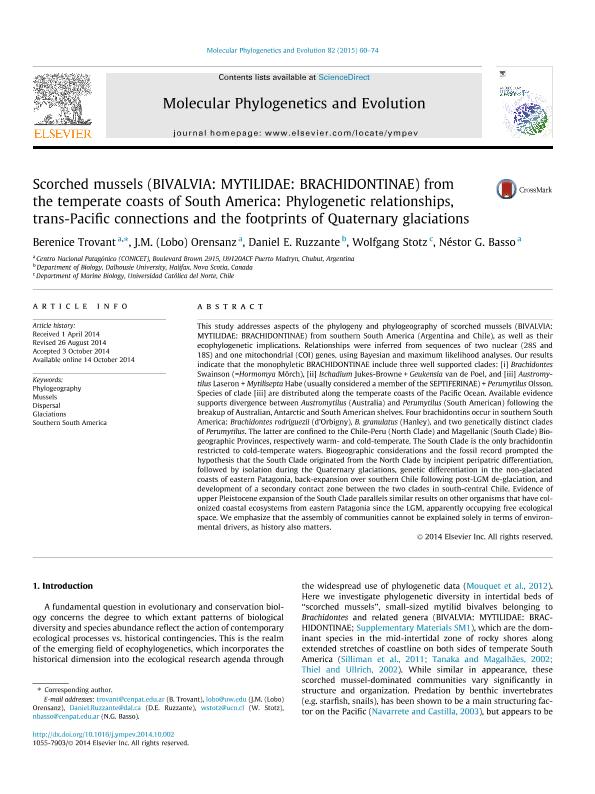Artículo
Scorched mussels (Bivalvia: Mytilidae: Brachidontinae) from the temperate coasts of South America: phylogenetic relationships, trans-Pacific connections and the footprints of quaternary glaciations
Trovant, Berenice ; Orensanz, Jose Maria
; Orensanz, Jose Maria ; Ruzzante, Daniel E.; Stotz, Wolfgang; Basso, Nestor Guillermo
; Ruzzante, Daniel E.; Stotz, Wolfgang; Basso, Nestor Guillermo
 ; Orensanz, Jose Maria
; Orensanz, Jose Maria ; Ruzzante, Daniel E.; Stotz, Wolfgang; Basso, Nestor Guillermo
; Ruzzante, Daniel E.; Stotz, Wolfgang; Basso, Nestor Guillermo
Fecha de publicación:
2015
Editorial:
Elsevier Inc
Revista:
Molecular Phylogenetics and Evolution
ISSN:
1055-7903
Idioma:
Inglés
Tipo de recurso:
Artículo publicado
Clasificación temática:
Resumen
This study addresses aspects of the phylogeny and phylogeography of scorched mussels (BIVALVIA: MYTILIDAE: BRACHIDONTINAE) from southern South America (Argentina and Chile), as well as their ecophylogenetic implications. Relationships were inferred from sequences of two nuclear (28S and 18S) and one mitochondrial (COI) genes, using Bayesian and maximum likelihood analyses. Our results indicate that the monophyletic BRACHIDONTINAE include three well supported clades: [i] Brachidontes Swainson (= Hormomya Mörch), [ii] Ischadium Jukes-Browne + Geukensia van de Poel, and [iii] Austromy- tilus Laseron + Mytilisepta Habe (usually considered a member of the SEPTIFERINAE) + Perumytilus Olsson. Species of clade [iii] are distributed along the temperate coasts of the Pacific Ocean. Available evidence supports divergence between Austromytilus (Australia) and Perumytilus (South American) following the breakup of Australian, Antarctic and South American shelves. Four brachidontins occur in southern South America: Brachidontes rodriguezii (d’Orbigny), B. granulatus (Hanley), and two genetically distinct clades of Perumytilus . The latter are confined to the Chile-Peru (North Clade) and Magellanic (South Clade) Bio- geographic Provinces, respectively warm- and cold-temperate. The South Clade is the only brachidontin restricted to cold-temperate waters. Biogeographic considerations and the fossil record prompted the hypothesis that the South Clade originated from the North Clade by incipient peripatric differentiation, followed by isolation during the Quaternary glaciations, genetic differentiation in the non-glaciated coasts of eastern Patagonia, back-expansion over southern Chile following post-LGM de-glaciation, and development of a secondary contact zone between the two clades in south-central Chile. Evidence of upper Pleistocene expansion of the South Clade parallels similar results on other organisms that have col- onized coastal ecosystems from eastern Patagonia since the LGM, apparently occupying free ecological space. We emphasize that the assembly of communities cannot be explained solely in terms of environ- mental drivers, as history also matters.
Palabras clave:
Phylogeography
,
Mussels
,
Dispersal
,
Glaciations
,
Southern South America
Archivos asociados
Licencia
Identificadores
Colecciones
Articulos(CCT-CENPAT)
Articulos de CTRO.CIENTIFICO TECNOL.CONICET - CENPAT
Articulos de CTRO.CIENTIFICO TECNOL.CONICET - CENPAT
Citación
Trovant, Berenice; Orensanz, Jose Maria; Ruzzante, Daniel E.; Stotz, Wolfgang; Basso, Nestor Guillermo; Scorched mussels (Bivalvia: Mytilidae: Brachidontinae) from the temperate coasts of South America: phylogenetic relationships, trans-Pacific connections and the footprints of quaternary glaciations; Elsevier Inc; Molecular Phylogenetics and Evolution; 82; Part A; -1-2015; 60-74
Compartir
Altmétricas



